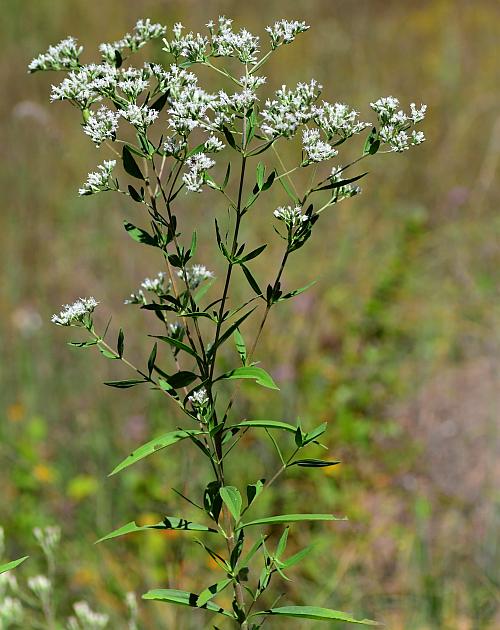Eupatorium altissimum L.
Tall Thoroughwort

Native
CC = 3
CW = 5
MOC = 74
© SRTurner
Eupatorium altissimum L.Tall Thoroughwort | |
 |
Native CC = 3 CW = 5 MOC = 74 |
© SRTurner |
|
Family - Asteraceae/Eupatorieae Habit - Fibrous rooted, rhizomatous, perennial forb. Stems - Erect, to 2 m, solid, branching in the apical 1/3, moderately to densely short-hairy above the nearly glabrous basal portion, green to yellowish green, sometimes purplish-tinged or brownish-mottled, some nodes often with small fascicles of axillary leaves less than 1/2 as long as the main stem leaves.
Leaves - Opposite, sometimes subopposite or alternate at uppermost nodes, simple, sessile or with poorly differentiated petioles to 15 mm long. Blades 2-15 cm long, 3-25 mm wide, narrowly lanceolate to lanceolate, tapered at the base, tapered to a sharply pointed tip, with 3 main veins from the very base, the margins entire or more commonly sharply toothed above the midpoint, the surfaces moderately to densely short-hairy, also densely gland-dotted.
Inflorescences - Terminal panicles of numerous heads, flat-topped or broadly dome-shaped. Inflorescence divisions subtended by a pair of reduced leafy bracts.
Heads - Discoid, cup-shaped to nearly cylindrical. Involucre 4.5-7.0 mm long, more or less cup-shaped, the bracts to 5 mm long, ovate to narrowly oblong, rounded to bluntly pointed at the tip, the margins thin and pale, mostly faintly 3-nerved, densely short-hairy, green. Receptacle nearly flat.
Flowers - Ray flowers absent. Disk florets usually 5 per head, the corollas 4-5 mm long, glabrous internally and externally, expanded in the apical 1/2, 5-lobed, the surface often somewhat glandular, white. Lobes acute, 1 mm long, 0.5 mm broad at the base, erect to spreading. Stamens 5, adnate at the apex of the contracted portion of the corolla tube. Pappus of capillary bristles, these antrorse-barbellate, white, 4-5 mm long. Filaments white, glabrous, compressed, 0.7 mm long. Anthers purplish, to 1.2 mm long, connate around the style, partially exserted. Style glabrous, green basally, white apically, to 6 mm long, bifurcate in the apical 3 mm (the divisions erect).
Fruits - Achenes 1.5-2.5 mm long, terete or 5-sided, glabrous. Flowering - August - October. Habitat - Prairies, glades, savannas, forest openings, streambanks, ledges and tops of bluffs, fields, pastures, ditches, quarries, railroads, roadsides, open disturbed areas. Origin - Native to the U.S. Lookalikes - Other species of Eupatorium, especially E. serotinum; also Brickellia eupatorioides. Other info. - This species is common throughout nearly all of Missouri. It is primarily a plant of the U.S. Midwest, though more scattered populations extend eastward to the Atlantic Coast. It is recognized by its inflorescences of small, discoid heads which usually contain five florets each, and which are usually a shade of "dirty dishwater" white. The leaves lack defined petioles and have three main veins which arise from the very base of the leaf blade. These characteristics serve to distinguish it from E. serotinum. Like most species in the genus, E. altissimum has a generally weedy aspect, but it is nevertheless a valued member of our native flora. The inflorescences are highly attractive to insects, and close inspection of any photo of this plant's flowers will usually reveal at least a few bugs nectaring somewhere amidst the florets ... as well as predators such as spiders also looking for a meal. As is commonly the case, plants growing in full sun are stouter, leafier, and have bigger inflorescences than do plants growing in the shade or in wooded areas. Photographs taken in Eminence, MO., 9-21-03, and at Tall Grass Prairie National Preserve, KS., 9-20-06 (DETenaglia); also at Shaw Nature Reserve, Franklin County, MO, 10-4-2007, Little Lost Creek Conservation Area, Warren County, MO, 9-6-2011, and Don Robinson State Park, Jefferson County, MO, 9-16-2021 (SRTurner). |